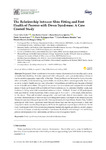| dc.contributor.author | López-López, Daniel | |
| dc.contributor.author | Calvo-Lobo, César | |
| dc.contributor.author | Ramos García, Ana | |
| dc.contributor.author | Losa Iglesias, Marta Elena | |
| dc.contributor.author | Rodríguez Sanz, David | |
| dc.contributor.author | Romero Morales, Carlos | |
| dc.contributor.author | Becerro-de-Bengoa-Vallejo, Ricardo | |
| dc.date.accessioned | 2022-03-23T13:49:30Z | |
| dc.date.available | 2022-03-23T13:49:30Z | |
| dc.date.issued | 2018-05 | |
| dc.identifier.citation | Calvo-Lobo, C.; Ramos García, A.; Losa Iglesias, M.E.; López-López, D.; Rodríguez-Sanz, D.; Romero-Morales, C.; Becerro-de-Bengoa-Vallejo, R. The Relationship between Shoe Fitting and Foot Health of Persons with Down Syndrome: A Case Control Study. Int. J. Environ. Res. Public Health 2018, 15, 983. https://doi.org/10.3390/ijerph15050983 | es_ES |
| dc.identifier.uri | http://hdl.handle.net/2183/30190 | |
| dc.description.abstract | [Abstract] Background: Down syndrome is the most common chromosomal abnormality and a cause of intellectual disability. It is also associated with orthopaedic and musculoskeletal problems of the locomotive apparatus, especially of the feet. These problems are believed to have a harmful effect on health, social functioning, and mobility. In addition, these persons generally don’t have access to podiatric health services, even when their foot problems are well known, because of limited access to healthcare facilities. The goal of our research was to evaluate and compare the foot health status of study participants with and without Down syndrome and to determine whether inadequate footwear is being used with normalized reference values. Methods: A total of 105 participants with and without Down syndrome, with a mean age of 35.71 (SD = 12.93) years, were enrolled in the study. They self-reported demographic data and their clinical characteristic data were recorded. Measurements of their foot and shoe fitting were taken at all stages of the research process. Ninety-two percent of the participants with Down syndrome had foot problems. Results: Only 12 (24%) participants with Down syndrome used bilateral shoes that met the requirements of their feet compared to their controls (50 participants, 90.9% for the right foot; 46 participants, 83.6% for the left foot). Participants with Down syndrome presented statistically significant differences with respect to controls and wore incorrectly sized shoe. Conclusions: Evaluation of foot length and width may prevent development of foot deformities, as well as to improve general health | es_ES |
| dc.language.iso | eng | es_ES |
| dc.publisher | MDPI | es_ES |
| dc.relation.uri | https://doi.org/10.3390/ijerph15050983 | es_ES |
| dc.rights | Atribución 3.0 España | es_ES |
| dc.rights.uri | http://creativecommons.org/licenses/by/3.0/es/ | * |
| dc.subject | Down syndrome | es_ES |
| dc.subject | Síndrome de Down | es_ES |
| dc.subject | Foot | es_ES |
| dc.subject | Pie | es_ES |
| dc.subject | Musculoskeletal disease | es_ES |
| dc.subject | Enfermedades musculoesqueléticas | es_ES |
| dc.subject | Shoes | es_ES |
| dc.subject | Calzado | es_ES |
| dc.title | The Relationship between Shoe Fitting and Foot Health of Persons with Down Syndrome: A Case Control Study | es_ES |
| dc.type | info:eu-repo/semantics/article | es_ES |
| dc.rights.access | info:eu-repo/semantics/openAccess | es_ES |
| UDC.journalTitle | International Journal of Environmental Research and Public Health | es_ES |
| UDC.volume | 15 | es_ES |
| UDC.issue | 5 | es_ES |
| UDC.startPage | 983 | es_ES |






